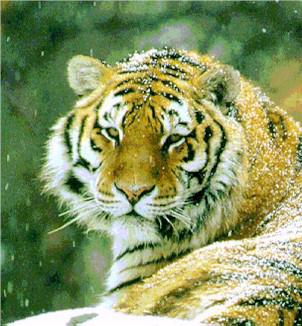



THE SIBERIAN TIGER IS THE LARGEST OF THE BIG CATS AND
 MEASURES OUT TO BE 4.6 TO 9.2 FT. LONG, NOT INCLUDING THE TAIL WHICH IS 27 TO 37 IN. LONG. THEY CAN WEIGH UP TO 675 lbs. THEIR FUR COATS ARE A YELLOWISH ORANGE WITH DARK STRIPES. THEY HAVE THE SAME BEHAVIORAL PATTERN AS THE BENGAL TIGER. MEASURES OUT TO BE 4.6 TO 9.2 FT. LONG, NOT INCLUDING THE TAIL WHICH IS 27 TO 37 IN. LONG. THEY CAN WEIGH UP TO 675 lbs. THEIR FUR COATS ARE A YELLOWISH ORANGE WITH DARK STRIPES. THEY HAVE THE SAME BEHAVIORAL PATTERN AS THE BENGAL TIGER. CLASSIFICATION:
CLASSIFICATION:SIBERIAN TIGER: PANTHERA TIGRIS ALTAICA
|
|
What They Say At:http://www.5tigers.org/siberian.htmThe Siberian or Amur tiger lives primarily in eastern Russia, and a few are found in northeastern China and northern North Korea. It is estimated that 437-506 Siberian tigers still exist in the wild. About 490 captive Siberian tigers are managed in zoo conservation programs.
In this century, the Siberian tiger (sometimes called the Amur, Manchurian, or Northeast China tiger), has survived four wars, two revolutions, and now an onslaught on its forests. Its IUCN status is considered Critical, its numbers in the wild fluctuating from a low of 24 tigers in the 1940s to IUCN estimates of about 150 to 200 in 1994. Recent conservation efforts have paid off, and as of 1997 there were estimated to be between 437-506 wild Siberian tigers. There are three protected areas for tigers in Russia-the Sikhote-Alin (3,470 km2), Lazovsky (1,165 km2), and Kedrovaya Pad (178 km2) Reserves-inland from the Sea of Japan in the Russian Far East.
Sightings of Siberian tigers in Changbaishan, near the Chinese border with North Korea, were reported in Chinese newspapers in 1990, and some are still found along the Russian border. The Cat Specialist Group suggests that there are probably fewer than 50 Siberian tigers in China. Regardless of their authenticity, it is the tigers in Russia that will define the future of the subspecies. The other sites are too small to harbor tiger populations large enough for long-term viability. The survival of wild Siberian tigers will be linked to securing and enlarging their current habitat and protecting them from poachers. The Law of the Russian Federation on Environmental Protection and Management of 1992 gave the Siberian tiger legal protection. Despite this, poaching has received considerable attention in the press, but the reports are rife with rumors. Authorities admit that the killing of tigers is a new enterprise, in part arising from on an unstable and worsening economic situation for most people, open borders to China and Korea, and a demand for tiger body parts for traditional Chinese medicine. Many agencies and organizations are promoting efforts to assist Russia in stopping the poaching on tigers and their prey, the marketing of their skins and bones, and the loss of available habitat.
The captive program for Siberian tigers is the largest and longest managed program for any of the subspecies. The Siberian tiger served as one of the models for the creation of scientifically managed programs for species in captivity in zoos and aquariums worldwide. According to the 1994 International Tiger Studbook there are about 490 Siberian tigers managed in zoos: 226 in Europe, 151 in North America, 93 in Japan, and about 20 more scattered among Asian zoos. This captive population is descended from 83 wild-caught founders. For the most part, the Siberian tiger is considered secure in captivity, with a large, genetically diverse and stable population
|